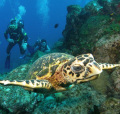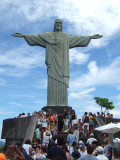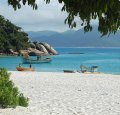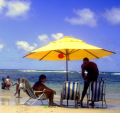South
 Friday, February 5, 2010 at 04:00PM
Friday, February 5, 2010 at 04:00PM The Southern Region of Brazil is the smallest region in the country, but it is still an important economic and cultural center with a lot of interest for tourists. It borders Uruguay, Argentina, and Paraguay, as well as the Central West and Southeast Regions of Brazil, and the Atlantic Ocean. Large numbers of European immigrants during the 19th century have had a large influence on region and culture.
The areas of greatest interest to tourists in the region include the capital city Curitiba, the coastal city Florianopolis, and Foz do Iguaçu region withthe magificentIguacu Falls
Curitiba
Curitiba, the capital city of the state of Paraná is an important cultural, political and economic center in the country. It is located on a plateau at 932metres (3,060ft) above sea level. It initially grew as a cattle trading centre but is today home to many industries. After 1850, waves of European immigrants started arriving, mainly Germans, Italians, Poles and Ukrainians, who contributed to the economic and cultural development of the city.
Today Curitiba is a wealthy city and is an international reference in term of good urban and environmental planning, with excellent leisure and transport systems. It also has an opera house and many theatres.
The city is a short distance from the coast and other sites that will interest tourists such as Blumenau, a city of Brazilians with German and Italian ancestry. The city displays many historical and cultural reminders of their heritage, such as houses and other buildings built in a traditional German style.
Florionopolis
Florianópolis, nicknamed Floripa, is the capital city of Santa Catarina State. It is composed of one main island, the Island of Santa Catarina (Ilha de Santa Catarina), a part on the continent, and the surrounding small islands.
The economy of Florianópolis is heavily based on tourism and services. The city has no less than forty two beaches and is a surfing hot spot.
It was described by Newsweek as one of the "Ten most dynamic cities of the world" and by the Brazilian Magazine Veja as "the best place to live in Brazil." As a consequence of this publicity, Florianópolis is growing destination for Paulistas, Argentines, U.S. citizens and Europeans, many of whom establish beach homes here.
Most of the population lives on the island's northern half. The southern half is less inhabitated. Many small commercial fishermen populate the island. Although originally settled by the Portuguese (from the Azores), the city has a strong German and Italian influence, like the rest of the state. Features of the region are the fishing boats, lacemakers, folklore, cuisine and distinctive architecture.
Click the link for the Florionópolis Guide
Porto Alegre
Porto Alegre is the capital city of the state of Rio Grande do Sul. Porto Alegre is an important cultural, political and economic region, bordered by Argentina and Uruguay. The city was founded in 1742 by immigrants from the Azores, Portugal, but received many more immigrants, particularly from Germany, Italy, and Poland, at the end of the 19th century. The vast majority of the population is of European descent.
The "Gaúcho capital" has a broad-based economy that lays particular emphasis on agriculture based production and industry. It has a long coastline, many hills and a unique ecosystem, rich in wildlife. Parks, gardens and nature reserves are the main focus of the tourism industry.
Iguaçu Falls
IguaçuFalls is one of the most popular, and spectacular, tourist destinations in Brazil and boasts over 100 hotels. The falls themselves are the main attraction on the triple boarders of Brazil, Argentina and Paraguay. They are 275 separate falls which tumble off a horseshoe-shaped precipice that is almost five kilometres wide. They have a flow capacity equal to three Niagara Falls.
The falls are within a protected area Parque Nacional do Iguaçu (Iguazu National Park), in both Brazil and Argentina, where the falls are. It is protected by the the environment agency IBAMA. Associated with the area are other attractions including:
- Itaipu Dam, the largest generator of hydro-electric power in the world, in the Parana river, between Brazil and Paraguay, which produces about 20% of Brazil's electricity needs.
- The Tríplice Fronteira (Triple Frontier) location where Brazil, Argentina and Paraguay meet. Each side has its own Marco (landmark).
- The Omar Ibn Al-Khattab mosque, the largest outside Middle East.
- The Bird Park (Parque das Aves)
The guide will cover all the attractions in this important area of Brazil.












